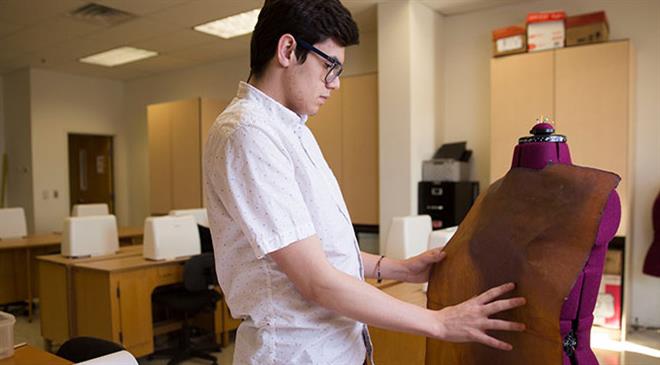Bacterial cellulose can be durable
Focusing on bold patterns and colour palettes, Luis Quijano, a student at the Liberty University in Lynchburg, Virginia, is successful in merging fashion with some unlikely counterparts - microbiology and mechanical engineering - to bring to life an idea that had long been only conceptualised: growing your own clothes. This senior fashion student has been working rigorously to create what he thinks could be the most innovative trend in fashion. Luis Quijano talks to Fibre2Fashion about using bacterial cellulose as a non-woven.
My journey started with speaking about bacterial cellulose. Then I decided to explore growing the material and had the opportunity to go to Australia last summer for research. Recently, I finished my senior honor thesis, applied for the Fulbright scholarship to study in Australia, and am currently writing conference papers on bacterial cellulose. The last few years have been years of continual growth and change. I would never have expected to be in the position that I am in the field of bacterial cellulose, and am looking further to continuing research on this textile.
With further R&D that can improve bacterial cellulose characteristics, homegrown clothing with this medium can definitely reduce waste in the apparel and textile industry. Bacterial cellulose is unique in that it circumnavigates most steps needed for textile manufacturing in the status quo.
With future R&D, I believe that bacterial cellulose can be made at a more affordable price that could be cheaper than natural fibres like cotton and wool. Referring to the previous question, bacterial cellulose cuts out most steps of the textile manufacturing process. It removes the usage of pesticides, converting fibres to yarns, yarns into fabric, and in the future can reduce or eliminate the need for cutting the fabric before sewing. Furthermore, it is more receptive to textile dyeing, reducing effluents and toxic chemicals.
My journey with bacterial cellulose started while watching a Tedtalk show of Suzanne Lee describing how to grow one's clothes. The process seemed abstract to me and raised my interest. Thus, I researched bacterial cellulose and delivered an informative speech for my Liberty University forensics speech team during my sophomore undergraduate year.
Bacterial cellulose and its research as a textile involve interdisciplinary means like microbiology and mechanical engineering. It involves microbiology because further research on modifying the bacteria to produce greater amounts of cellulose is necessary. Furthermore, mechanical engineering is needed to test its capabilities as research progresses with bacterial cellulose as a non-woven.

It is possible to dye bacterial cellulose. As for digitally printing designs, I am unsure. I know that the QUT and the State Library of Queensland used a laser cutter to create a watch with intricate details. As for embroidery, Sacha Laurin has shown bacterial cellulose can withstand additional details.

I have used white sugar, green tea, kombucha tea and distilled or boiled water as well as coconut oil, food colour and vinegar. In comparison to the status quo of how most textiles are produced, bacterial cellulose can be considered to be more eco-friendly.
I intend to modify the manufacturing process by researching and utilising more efficient growing processes so that bacterial cellulose may be grown faster. In addition, I intend to explore methods of waterproofing bacterial cellulose.
Corporations have placed greater emphasis on corporate social responsibility and transparency in the last few years. Organisations want to give back more to the communities around them and consumers want to know whether their garments are manufactured using underage child workers, sweatshops and other abusive norms.
Sustainable fashion in future will most likely explore further alternative textiles and utilising by-products or waste products in the creation of textiles.
Each batch that one grows may consist of variations in thickness, colour and length depending on the size of the container and the ingredients used.
Bacterial cellulose is very receptive to colours. In addition, detailing and ornamentation appears to be characteristics that bacterial cellulose can support. Sacha Laurin, founder and owner of Kombucha Couture, has utilised these various processes in creating elaborate garments from bacterial cellulose.
Smart technology and bacterial cellulose combined may have enormous possibilities. Although I am not aware of any current initiatives that have jointly utilised the two methods, the notion of bacterial cellulose utilising smart technology seems very amenable.
Because the process of growing your own bacterial cellulose is public knowledge, it is not possible to patent that process. However, if efficient techniques or machinery and products made to grow bacterial cellulose in an improved manner were discovered, I would look into patenting those. In terms of commercial production, it ultimately is dependent on how fast R&D can take place for primarily waterproofing the textile, and subsequently instilling more desirable traits within the textile's properties.

No official cost analyses have been done to figure out how much cost goes into the fabric per yard or meter. However, the potential of bacterial cellulose makes it economically viable and practical. It is most optimally grown at room temperature, meaning anyone can grow it in his home.
Bacterial cellulose is currently in its research phase of improving the textile to become a commercial standard. This roadmap may consist of international research collaborations or various researchers analysing the ingredients to grow bacterial cellulose, shortening the growth cycle, waterproofing and experimenting with bacterial cellulose and design process.
As the research continues, modifying the fabric thickness, consistency, durability, growth cycle speed, and design techniques would be the various qualities that I would be eager to research.
In my upcoming senior design collection that I will be presenting in April, I am planning to include in my designs sustainable aspects, such as bacterial cellulose, reversible wear, zero waste design and digital printing.
DISCLAIMER: All views and opinions expressed in this column are solely of the interviewee, and they do not reflect in any way the opinion of technicaltextile.net.